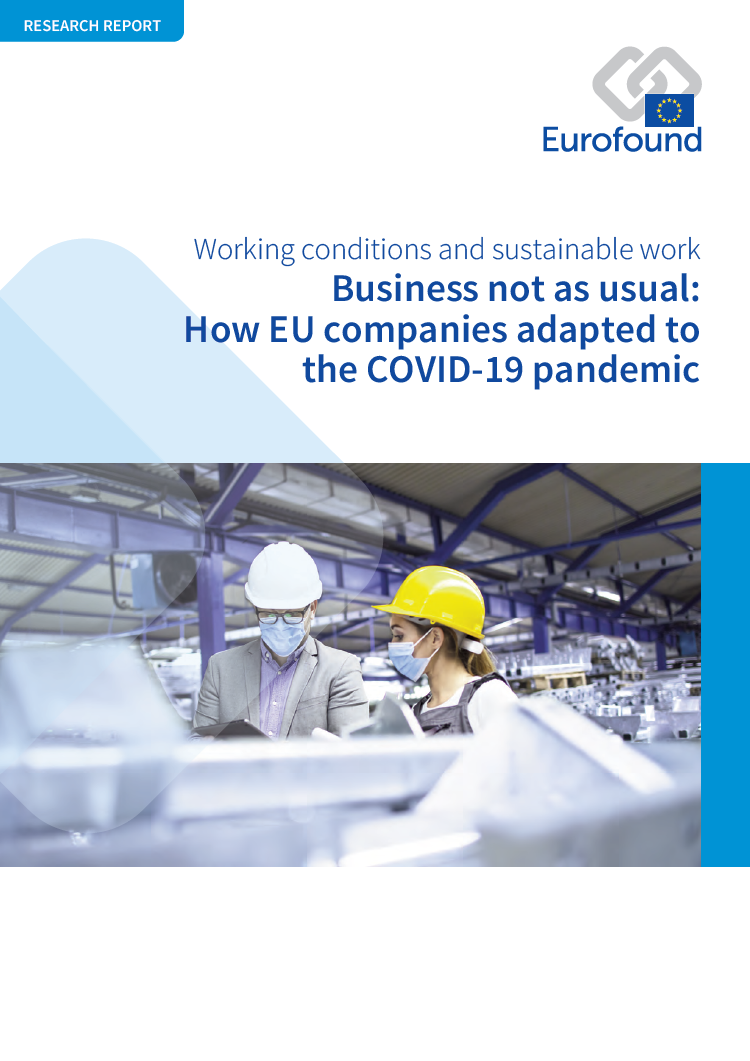
This report aims to support European businesses in navigating the challenges of the COVID-19 pandemic. The focus is on workplace practices and features that have helped establishments across the EU to develop operational resilience while keeping employees and customers safe. The report investigates how EU establishments initially reacted to the external shock brought about by the outbreak of the pandemic and how they subsequently adapted their workplaces. It also explores the impact of the pandemic on the health and well-being of workers and how the COVID-19 outbreak and subsequent disruptions affected business operations and work organisation.
Key findings
As a result of the pandemic, nearly 1 in 5 EU businesses experienced job losses. Almost 40% of EU establishments had to cut their employees’ working hours, and in nearly a quarter (23%) this affected most workers.
In 2020, almost half of all EU businesses had to cease operations in some way because of COVID-19. Providers of financial and other services, transport companies and those in the hospitality sector were hit hardest by the impact of successive lockdowns linked to public health measures.
In 2020, over one-third of EU establishments changed their main business activity in response to COVID-19. Many companies shifted their production lines to producing urgently needed protective equipment, respirators, sanitising tools and other apparatus.
Organisations can draw clear lessons from the crisis. Businesses that invested in employees and involved them in decision-making fared better; these high-investment, high-involvement establishments were also more likely to have a crisis management plan in place, change their core business activities and hire additional staff in 2020. Forward-looking management was also critical, along with a good workplace climate, an effective strategy for communicating with staff and clients, and providing staff with equipment to enable flexible working-time arrangements.
The physical and emotional challenges during the COVID-19 crisis have been different for on-site and home-based workers. Although both types of workers mentioned pandemic fatigue and low motivation, teleworkers cited poor ergonomic design of remote workplaces, the difficulties of home schooling and frustration with monotonous environments, while on-site workers highlighted fear of contagion and radically changed workplace practices.
This report contains the following list of tables and figures.
List of tables
Table 1: Distribution of Eurofound case studies
Table 2: Reduction in working time due to COVID-19, by establishment characteristics
Table 3: Average establishment performance levels by establishment characteristics, indexed mean, standard errors and % change in indexed mean
Table 4: Findings on telework-related aspects (%)
Table 5: Establishment performance and workplace well-being by work characteristics and management style, mean and standard errors
List of figures
Figure 1: Change in number of employees by sector, 2019 and 2020 (%)
Figure 2: Change in number of employees by establishment type, 2019 and 2020 (%)
Figure 3: Reduction in working time due to COVID-19, by sector (%)
Figure 4: Proportion of establishments reporting profit/loss, 2019 and 2020 (%)
Figure 5: Proportion of establishments reporting increases/decreases in production volume, 2019 and 2020 (%)
Figure 6: Complete or partial suspension of business (%)
Figure 7: Complete or partial suspension of business activity by sector (%)
Figure 8: Change in employment by degree of business suspension (%)
Figure 9: Profit outlook by business suspensions (%)
Figure 10: Production/service volume developments by business suspensions (%)
Figure 11: Change in business activities by sector and disruption (%)
Figure 12: Change in knowledge and skills needs due to COVID-19, EU27 (%)
Figure 13: Establishments with substantial or moderate change in knowledge and skills needs due to COVID-19, by establishment type, EU27 (%)
Figure 14: Motivation by types of change in establishments (%)
Figure 15: Change in establishments’ physical infrastructure due to COVID-19 (%)
Figure 16: Change in establishments’ physical infrastructure due to COVID-19 by sector (%)
Figure 17: Organisational changes due to COVID-19 by sector (%)
Figure 18: Telework by proportion of employees and time, 2019 and 2020 (%)
Figure 19: Telework by establishment size, 2019 and 2020 (%)
Figure 20: Provisions for telework made by employer (%)
Figure 21: Extent to which each element of the management approach has become more important because of the pandemic (%)
Figure 22: Problem solving and work autonomy, 2019 and 2020 (%)
Figure 23: Job complexity and work autonomy, indexed values (mean = 100), 2019 and 2020
Figure 24: Discretionary behaviour, 2019 and 2020 (%)
Figure 25: Use of internal communication channels, 2019 and 2020 (%)
Figure 26: Business continuity plan or contingency plan previously in place by various variables (% and standard errors)
Figure 27: Psychosocial risks in EU27 establishments in 2019 (% of managers reporting)
Figure 28: Measures to record working time by employee representation (ER) (%)
Figure 29: Employee motivation by employee representation (ER) (%)
Figure 30: Direct employee participation (%)
- Number of pages
-
80
- Reference nº
-
EF21033
- ISBN
-
978-92-897-2224-7
- Catalogue nº
-
TJ-05-21-333-EN-N
- DOI
-
10.2806/98958
- Permalink
Cite this publication
Eurofound (2021), Business not as usual: How EU companies adapted to the COVID-19 pandemic, Publications Office of the European Union, Luxembourg.
